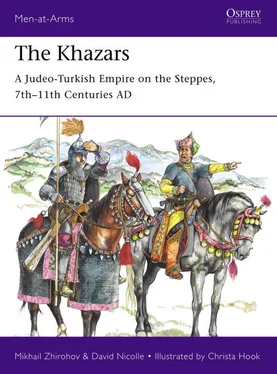During the 9th and 10th centuries the number of bone elements decreases; the most common form is known as the ‘Saltov’ bow, which often had only one small upper frontal bone plate with a nock and grooves for the bowstring. A significant reduction in the weight of arrows also indicates that the power of the bow had decreased with this loss of bone plates, perhaps reflecting a change in horse-archery tactics.
A typical Khazar bowstring had loops to fit over the tips of the stave, which made it easier to replace a worn or damaged string and prolonged the weapon’s useful life. The string itself consisted of twisted cords of bull hide or braided sheep intestines, though silk threads were also used.
Substantial numbers of very varied arrowheads have been found in burials. Those from the Khazar period are iron and are generally leaf-shaped. In section the great majority are three-bladed; other forms such as two-bladed, flattened triangular, rhomboid, trapezoid, and some other styles are fewer in number. A noticeable decrease in the size of arrowheads, starting in the second half of the 8th century, along with the appearance of specialized armour-piercing types, was probably due to an increasing use of armour, perhaps especially mail. Small arrowheads are almost universal among the finds, though these also include some large examples with an almost chisel-shaped blade intended to cause the broadest possible wound to an unarmoured man or horse. In contrast the slenderest forms were designed to penetrate armour, especially mail. The earliest known examples of small, narrow, three-bladed armour-piercing arrowheads were found in Voznesenka in the Voronezh region of Russia, together with fragments of mail armour. No quivers survive from this period in the Khazar territories, only the metal loops and hooks by which they were carried.
Swords
The well-known reference to the Slavs paying tribute to the Khazars in the form of swords has sometimes been taken as evidence that straight, double-edged swords were superior to the single-edged sabres otherwise used by Khazars. Arguing against this is not only the interpretation of such tribute as a disarmament of the defeated, but the plain facts that sabres were not only still used by the Khazars right up until the collapse of the Khaganate under Russian pressure in the 10th and 11th centuries, but remained the most popular close-combat bladed weapon amongst steppe nomadic horsemen◦– and many other cavalry◦– for centuries to come. It may also be the case that the spread of sabres in much of Eastern Europe was closely associated with the Khazars.

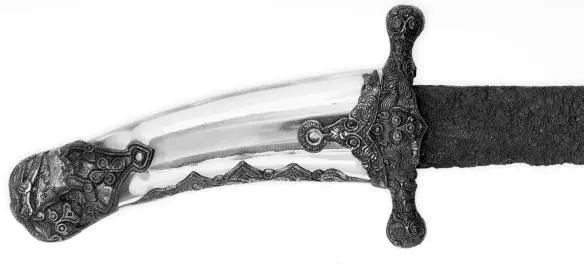
Khazar-style sabre and scabbard furniture from the Caucasus, 10th century, with detail of hilt. (Furusiyah Art Foundation, inv. R-645)
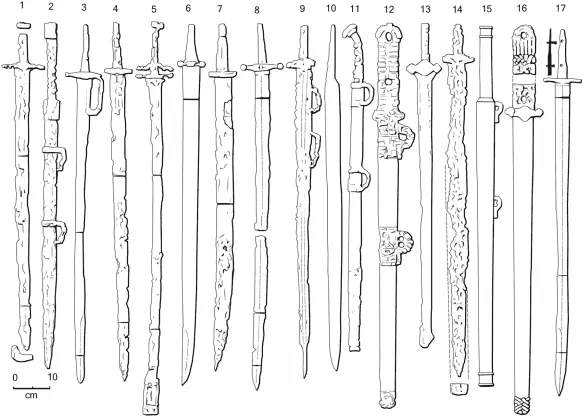
Khazar swords and sabres, shown as they were found, with and without scabbards or their metal fittings:
(1, 4 & 5) from Dmitrovka; (2) from Syvashovka; (3) from Starokorsunskay; (6) from Kaazazovo; (7) from Stariy Saltov; (8) from Krasnaya Gorka; (9) from Krivay Luka; (10) from Arcibashevo; (11) from Verhniy Saltov; (13) from Vosnesenka; (14) from Zaplavka; (15) from Vinogradnoye; (17) from Sukhaya Gomolsha. (12 & 16) are reconstructions after A.K. Ambroz. (Drawings by A. Karbivnychyi after V. Kriganov)
In the second half of the 7th century the swords found in steppe warrior burials are, with very few exceptions, single-edged ‘sabre’ types ranging in length from 75cm to 100cm including hilts (29.5–39.4in). The appearance of increasingly curved blades reflected a search for greater effectiveness in mounted combat, and in many 7th-century single-edged weapons the hilt was also curved towards the cutting edge. This style is unlikely to have been invented by the Khazars themselves, but was probably borrowed from the Persians. There is, however, no scholarly consensus regarding the origin of distinctive ‘D’ or ‘P’-shaped projections on the scabbard to attach the suspension straps.
In the mid-8th century the warriors of the Khazar Khaganate adopted an early form of curved or true sabre. According to A.V. Kryganov, the renowned expert on nomad weaponry:
The length of the cutting part of the blade varies between 650 and 860mm (25.6–33.8in), more often being between 680 and 750mm; hilts are between 70 and 130mm long, usually 80 to 110mm (31.5–43in); the width of the blade is between 30 and 44mm, more often 30 to 35mm (1.2–1.4in). Curvature is either uniform along the entire length of the blade, or is only in the last third of the blade. The hilt is either straight, or … bent toward the cutting edge. The ends of the blades are almost double-edged. [2] Kryganov, A.V., Armament and Equestrian Equipment of Nomads of the South of Eastern Europe in the 7th–10th Centuries (Historical science thesis, in Russian; Kharkov, 1987) 60–61
A certain thickening towards the end of the blade may have produced greater striking power, or may simply have resulted from giving the weapon a doubled edge towards its point. In contrast to the 8th–9th century Khazars’ highly effective close-combat cavalry or infantry weapon, the early Russian sword was really only effective on foot.
Daggers and fighting knives
Daggers traditionally served as auxiliary close-combat weapons amongst foot-soldiers, so it is not surprising that they did not immediately become widespread among the nomadic horse-riding population of the Khazar Khaganate. Early daggers did not significantly differ in shape from smaller knives, usually being single-edged with a straight grip. At the end of the 7th century a Turkish type of larger fighting knife, sometimes with a grip markedly curved towards the cutting edge, spread among the Khazars. This weapon, unknown earlier in Europe, may have been of Soghdian Central Asian origin, where it was the ancestor of the khanjar which then spread across most of the Islamic world and beyond.
Spears
Across the Volga-Ural steppe region, metal spearheads had been known from the middle of the 3rd millennium BC. These had sockets rather than tangs for attachment to wooden shafts, often with an additional crimping ring which fixed the head more securely.
Khazar burials of the 7th century rarely contain spearheads; only at the turn of the 7th–8th centuries do spearheads with slender tetrahedral (i.e. ‘diamond-section’) blades appear in a Khazar context. The appearance of this form of weapon also coincided with fragments of mail armour being found in such burials. More specifically armour-piercing types of spearheads appeared in the 8th to 10th centuries, and were especially associated with the highly developed Saltov-Khazar culture. The majority of spearheads found in graves of both nomadic and settled Khazars, as well as in Alan and Bulgar burials, are of this basic form. Broader, leaf-shaped spearheads designed for engaging warriors who were unprotected by armour are rare, but there are nevertheless two main variants: spearheads with a diamond-shaped section, and two-ended spears having a metal butt or ferrule that could also be used to strike. Meanwhile, thrown javelins were only used in the Khaganate by Slav and Finno-Ugrian tribal warriors.
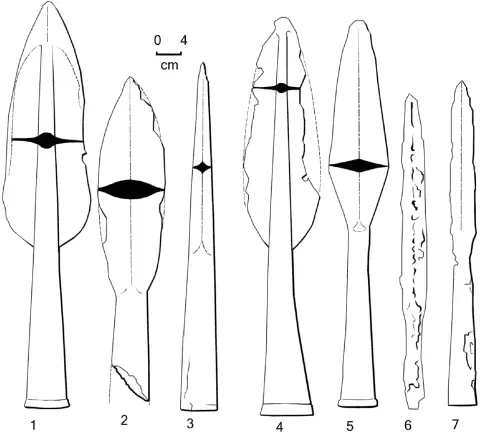
Khazar spearheads: (1–5) from Krasnaya Gorka; (6) from Glodosi; (7) from Novogrigorievka. (Drawings by A. Karbivnychyi after V. Kriganov)
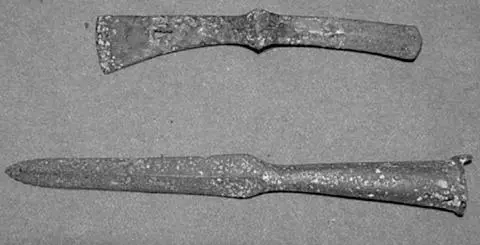
Battle-axe and spearhead found amongst the grave-goods of a Khazar warrior, whose helmet decoration suggested that he was Jewish. (Private collection)
The spearheads were mounted on slender wooden shafts, 3 to 4m long and up to 4.5cm in diameter (9ft 9in–13ft, x 1.8in); nowhere along its length was the shaft much thicker than the maximum diameter of the socket (from 0.8 to 1.7in). The shafts were made from straight saplings or pollard-poles of young trees, of species which varied with the local climates. As a rule, saplings were cut in late autumn or early winter during the period of minimum sap flow; they were then straightened and allowed to dry, after which the wood was scraped and polished to the desired size and shape.
Читать дальше
